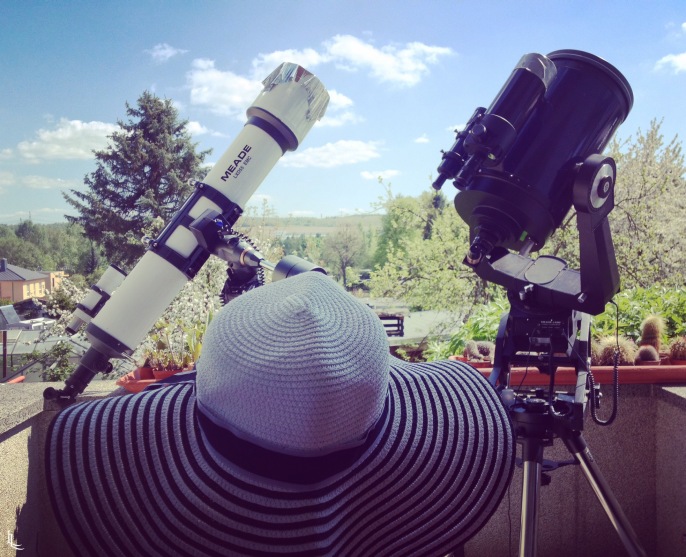Hello, Lina here! 🙂
The weather’s getting warmer, the days are longer and there’s more time with sunlight to be outside doing all kinds of things that you love doing in summer. However, with this time of the year approaching on the northern Hemisphere some precautions must be taken, like protecting your skin from solar rays.
Here in Germany, I notice that people get really excited when summertime is approaching because we normally have only 3 good months of summer, and the other 9 ones are often cloudy and cold, so when it’s sunny and warm everyone is outside enjoying the sun as much as they can.
We all need sun exposure because that is the top source of vitamin D, which helps our bodies absorbing calcium for stronger and healthier bones. But repeated unprotected exposure to the sun’s ultraviolet rays (UV) can cause skin and eye damage, immune system suppression and skin cancer.
Sunlight contains 3 types of ultraviolet rays: UVA, UVB, and UVC.
1. UVA: These rays pass effortlessly through the ozone layer and penetrate your skin very deep, causing premature skin ageing, wrinkles and with enough exposure, skin cancer like melanoma. You also have to protect your skin from UVA rays on cloudy days.
2. UVB: These are the ones that are absorbed by the ozone layer but some of these rays pass through it, enough to cause you sunburn, cataracts and effects on the immune system.
3. UVC: UVC rays are the most harmful ones but they are blocked by the ozone layer and don’t reach Earth, so theoretically you don’t need to worry about those.
So, here’s a list of things that you can do to protect yourself from UV damage:
- Wear Sunscreen
Ok. I know you are probably tired of hearing this, but here I am to tell you again: Seriously, wear sunscreen. Period. No matter if you have a dark tone skin or a light tone one. No matter if it’s summer or winter, sunny or cloudy. Do a favour to your skin and wear a sunscreen every day.
- Avoid the Strongest Rays of the Day
Between 10:00 a.m. and 4:00 p.m. is the period of time when the sun’s rays are strongest and if you can avoid going outside during this time, great. However, this is a really long period of time and who wants to hide indoors when the day is beautiful for outdoor activities?! So, make sure you apply and reapply your sunscreen and seek for some shade whenever you can.
- Keep Hydrated
Drinking water is an important part of staying healthy, even more on hot days. When you’re sweating you lose water that your body needs to work properly. So the more you sweat the more you should drink. Also, try not to wait until you feel thirsty because that helps to keep the water levels in your body high, without the danger of them dropping too low and you ending up dehydrated. On a plus side, the water makes your skin look plumper and beautiful.
- Use a lip balm SPF 30
Keeping your lips protected from the sun rays is very important, too. And you can find a proper lip balm quite easily in a drugstore.

- Wear Proper Clothes
Unless you are at the beach wearing your bathing clothes, you can double protect your skin and shield it from UV rays by wearing proper clothes. Place your hand inside the garments and make sure you can’t see it through them. Cotton fabric is great for that.
- Wear Sunglasses
Yes. You also must protect your eyes from sun rays. The direct exposure can cause corneal burn and cataracts. So, make sure you are wearing 100% UV protection sunglasses.
- Wear Hats
One of the things I love most about summer is that you can wear very stylish hats, I’m a hat lover so I’m suspicious to judge BUT, you really should wear hats whether you are at the beach or not. The hat will provide protection to your face, preventing your skin from premature ageing and wrinkles.

•••
My important tips when you’re selecting a Sunscreen:
- Choose a sunscreen that protects against both UVA and UVB rays (look for the words “broad spectrum” on the label or PA and SPF).
- Choose a PA++++, if you can.

- Choose an SPF 30 or higher to prevent sunburn and tanning.
- Choose a sunscreen that says “nonacnegenic” or “noncomedogenic” on the label, that will help to keep your pores clean.
- Don’t wear sunscreens with PABA, because they can cause skin allergies.
Additional Notes:
- SPF stands for Sun Protection Factor and refers to the amount of time you can be exposed to UVB rays without burning, not the strength of the sunscreen.
- PA stands for Protection Grade of UVA rays and is based on the Persistent Pigment Darkening (PPD) reaction reading at 2-4 hours of sun exposure. It’s levelled as PA+, PA++, PA+++ and PA++++, the more plus signs the more protection from UVA rays.
- Even though many products are labelled as “broad spectrum” they might not give effective protection against UVA and UVB. So look for the ones that contain: zinc oxide and titanium dioxide.
- Some medications can increase your sensitivity to the sun. So if you’re taking medication, increase your sun protection. But to be sure ask a doctor or pharmacist because sometimes not even sunscreen is sufficient to protect skin from sun sensitivity caused by medications.
- Apply a sunscreen with higher SPF when you’re around reflective surfaces that intensify the sun rays, like water, sand, and even concrete. That also applies to cloudy and cool days.
- Apply the sunscreen all over your body and don’t forget ears, hands, feet and behind the neck.
- Read the label on your sunscreen, they often indicate how often you need to apply (normally every 2 hours, even if it’s waterproof).
- If you are like me and don’t like to be toasting under the sun but still want that tan glow, try faking it with a self-tanner sunscreen. Just make sure you choose one with good UV protection because many offer too little or none.
- Now here’s the catch for makeup: I said up there to choose sunscreens with titanium dioxide and zinc oxide for their UV protection ability. However, those 2 ingredients are responsible for the “flashback makeup effect” that we see so much. So, if you plan on taking photos with direct flash, don’t use these sunscreens under your makeup because otherwise, you’re gonna look with a white face on the photos. (Also check your makeup labels and look for these 2 ingredients including silica).
•••
So, guys, that was a lot of information for today. I hope you enjoyed it. But tell me, how do you deal with summer and the sun? Do you protect your skin? Do you use some special sunscreens? Let me know in the comment section.
Many kisses and see you soon! 🙂

One Comment Add yours